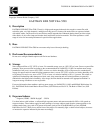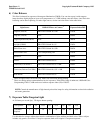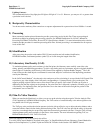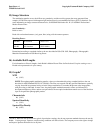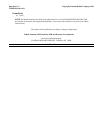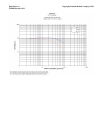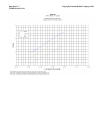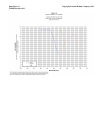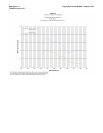
Data Sheet—3 Copyright, Eastman Kodak Company, 1993
TI2082 Revised 10-93
Lighting Contrast -
The recommended ratio of key-light-plus-fill-light to fill light is 2:1 or 3:1. However, you may use 4:1 or greater when
a particular look is desired.
8) Reciprocity Characteristics
You do not need to make any filter corrections or exposure adjustments for exposure times from 1/1000 to 1 second.
9) Processing
Most commercial motion-picture laboratories provide a processing service for this film. There are no packaged
chemicals available for preparing the processing solutions. See KODAK Publication No. H-24.07, Manual for
Processing EASTMAN Color Films, Process ECN-2 Specifications, Module 7, for more information on the solution
formulas and the procedure for machine processing these films. Normal processing is recommended for all exposure
levels of this film.
10) Identification
After processing, the product code number 5298 (35 mm) emulsion and roll number identification,
KEYKODE number, and internal product symbol (T) are visible along the length of the film.
11) Laboratory Aim Density (LAD)
To maintain optimum quality and consistency in the final prints, the laboratory must carefully control the color
timing, printing, and duplicating procedures. To aid in color timing and curve placement, negative originals should be
timed relative to Laboratory Aim Density (LAD) Control Film supplied by Eastman Kodak Company.
2
The LAD
Control Film provides both objective sensitometric control and subjective verification of the duplicating procedures
used by the laboratory.
In the LAD Control Method,
3
the electronic color analyzer used for color timing is set-up with the LAD Control Film
to produce a gray video display of the LAD patch, corresponding to 1.0 neutral density (gray) on the print. The
negative printing original is then scene-to-scene timed. There are specific LAD values for each type of print or
duplicating film that the original can be printed on. For print films, the LAD patch is printed to a neutral gray of 1.0
visual density. For duplicating films, the specified aims are at the center of the usable straight-line portion of the
sensitometric curve of the film.
12) Film-To-Video Transfers
When you transfer the film directly to video, you can set up the telecine using the negative Telecine Analysis Film
(TAF) supplied by EASTMAN Kodak Company. The TAF consists of a neutral density scale and an eight-bar color
test pattern with a LAD gray surround.
The TAF gray scale provides the telecine operator (colorist) with an effective way to adjust subcarrier balance and to
center the telecine controls before timing and transferring a film. The TAF color bars provide the utility of electronic
color bars, even though they do not precisely match the electronically generated color bars. Using the TAF will help
obtain optimum quality and consistency in the film-to-video transfer. For more information regarding TAF, see
KODAK Publication No. H-9, TAF User's Guide.
2
Direct any inquiries to one of the regional sales offices.
3
Use of the LAD Control Method is described in the paper, "A Simplified Motion-Picture Laboratory Control Method for
Improved Color Duplication," by John P. Pytlak and Alfred W. Fleischer in the October 1976 SMPTE Journal.



